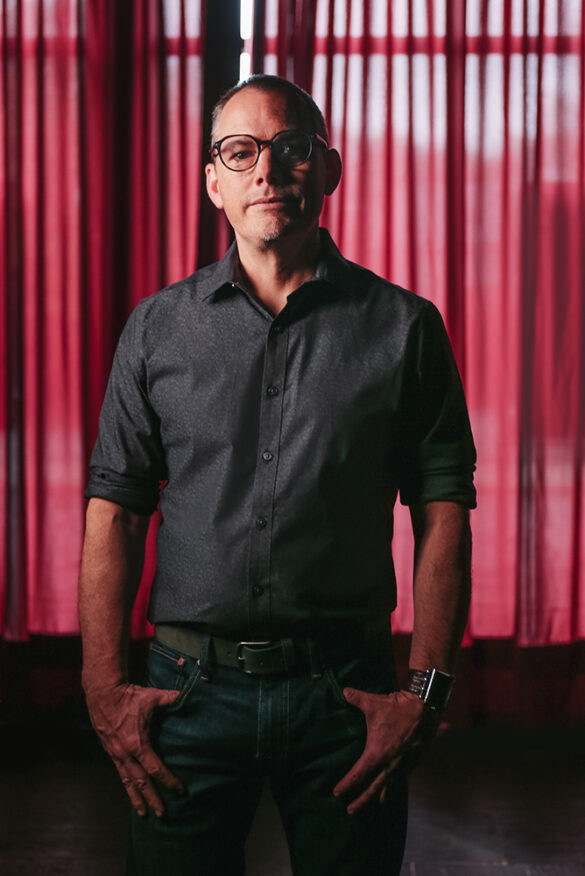
Don Widmer is a Chicago-based papermaker whose primary practice involves pulp painting, a form of papermaking in which finely beaten and highly pigmented pulp is ‘painted’ on a base sheet of pulp. His current architectural investigations are created entirely out of plant fiber. Widmer began exploring his architectural study while obtaining his MFA in Interdisciplinary in Book and Paper Arts at Columbia College, where he took part in transforming a CTA train car into an art gallery.
Widmer was interviewed by 2021 Fall Intern Alice Zakharenko. She is in her final year for her Bachelor’s degree in Fine Arts, concentrating in relief printmaking and monotyping. They discussed art fairs, the papermaking community, and Chicago landscapes among many other topics.
Alice Z (AZ): I understand that native Chicago buildings and landscapes are intricately embedded in your ongoing practice because they are a part of your daily life. Is there a reason why you choose certain structures to illustrate?
Don Widmer (DW): It’s mostly storytelling. I love dark, mysterious stories. [Imagery of] Ship disasters and buildings that have an interesting backstory are very appealing to me. I made a fantasy image of a dirigible descending over the Medina Athletic Club, which is the Intercontinental Hotel in Chicago. I researched it and nothing ever mounted that spire, but it’s just fascinating to think about the concept of a dirigible hovering above that building. I love these backstories; either I find them on my own or people tell me about them.
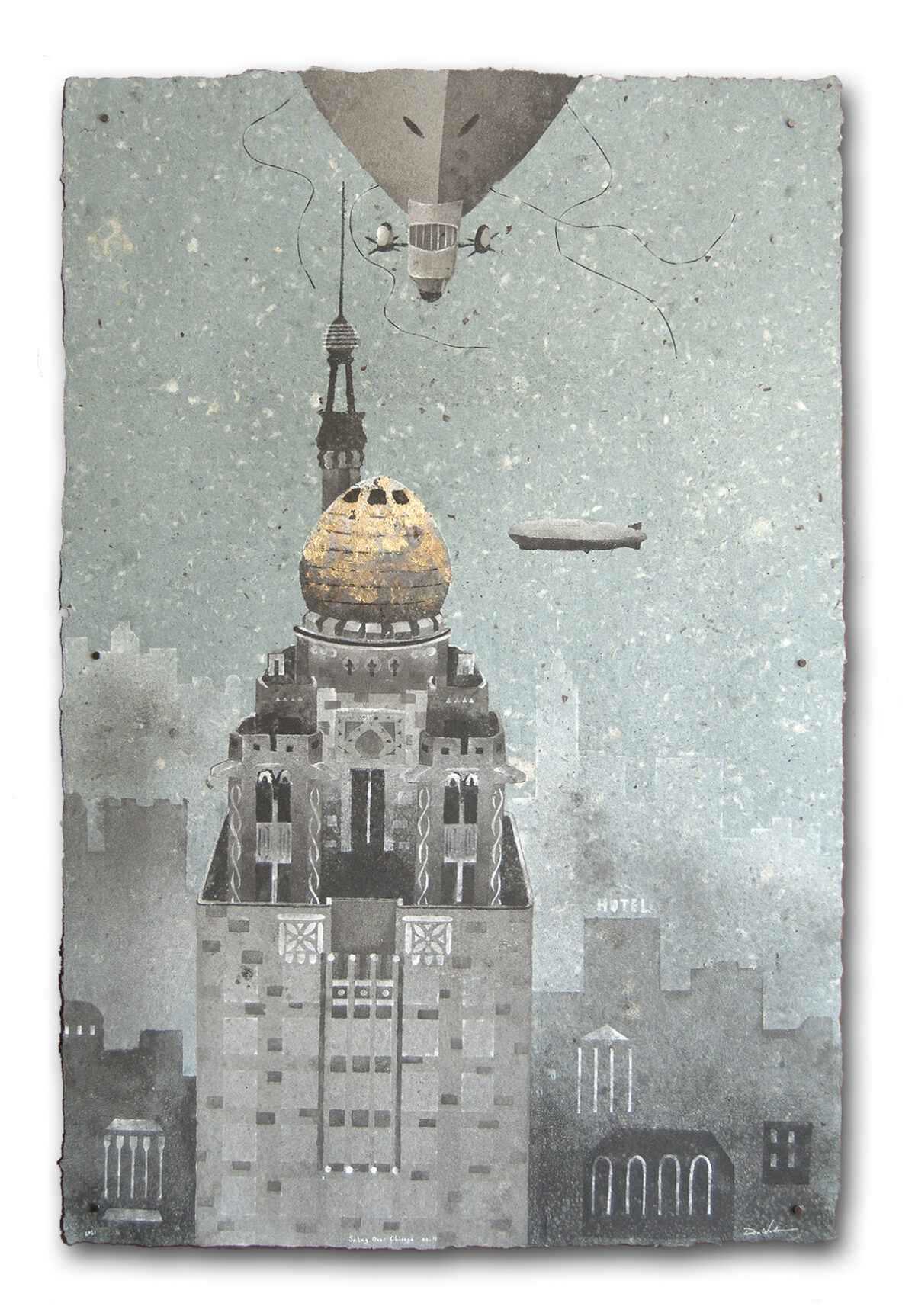
“Sailing Over Chicago No. 1”, 2018 pulp painting on handmade abaca and cotton rag paper 36 x 24 inches ; 91.4 x 61 cm
AZ: The concept of storytelling and buildings ties in with memories. Do you want to have more of a personal connection with these architectural images?
DW: I think when I first started doing architectural imagery, I was more interested in trying to represent a building in the best way I could without really thinking about the concept of memory or what type of an image I was creating. As I’ve looked at the results that I’ve gotten and what images I think are the most successful, I realized that there’s sort of a haziness to them. […] They seem to have a life of their own, like they may have been created 50 years ago. I started thinking about working with historic imagery, creating almost fantasy images of buildings based on how I look at their architectural renderings. With the Athletic Club, the dirigible hovering above it creates a scene that has never existed, but it could really spark the imagination in a way.
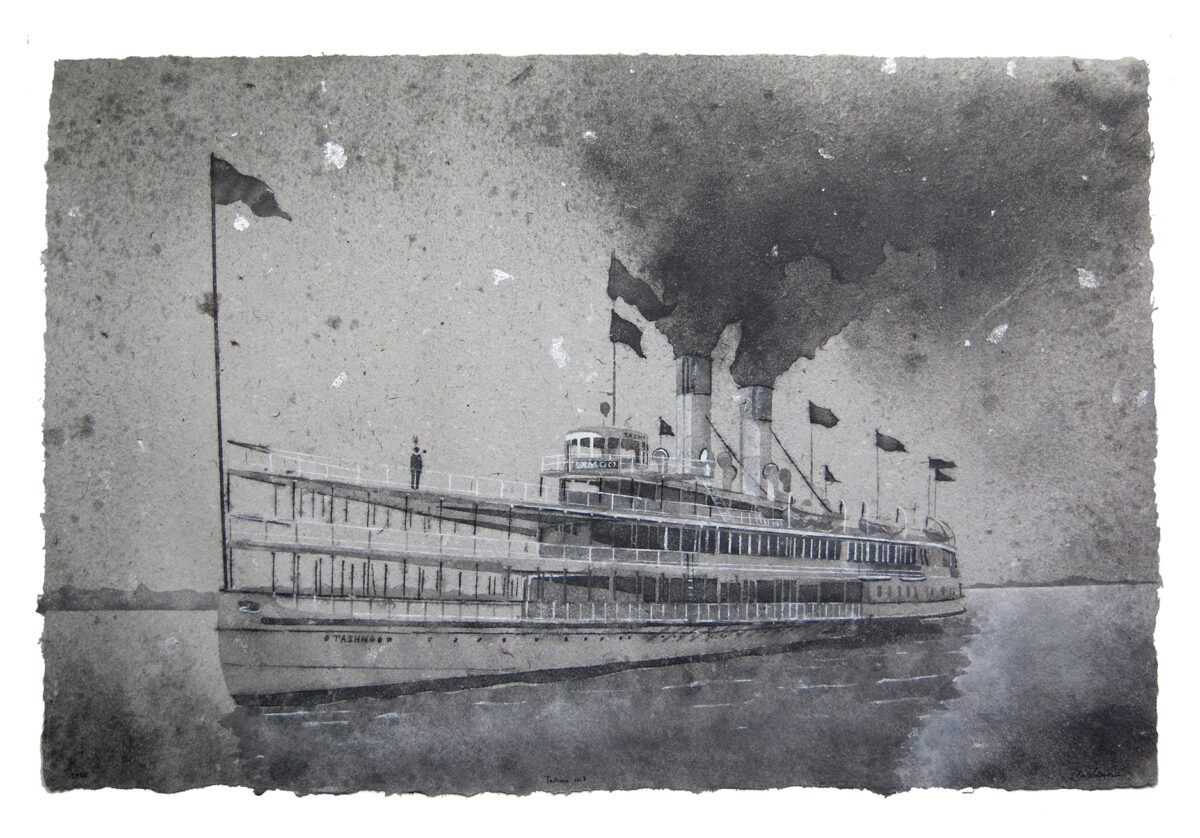
“Tashmoo No. 3”, 2020, lax pulp painting on handmade denim / linen / hasta paper with metallic foil inclusions, 24 x 36 inches; 61 x 91.4 cm.
AZ: Are you trying to memorialize these buildings or are you trying to preserve the memories that they once had?
DW: Sometimes. You know, I haven’t really thought about that, but I think both are true. Like, I have done images of the Mitchell Domes in Milwaukee because they were going to tear them down since they were starting to decay. People found the funding for them, so they’ve kept them. In a way, I was really interested in preserving the images of these really remarkable dome structures because they’re so interesting. I think that there is a part of my practice that wants to remember this image or to get people to talk about it, look at it, and ask about it.
AZ: It’s interesting to see that everything revolves around storytelling and amplifying the fact that we still need oral traditions to have a connection. I was wondering about your experiences in art fairs. Does the venue tend to change the context of your work when you’re displaying in a gallery on white walls versus interacting with everyday people?
DW: It does. It is different. It’s really being in touch with just the general public. There are people who are visiting my booth at art fairs who might never go to an art gallery, and there are also people that are very educated in art and architecture. I mean, I love it, because it keeps my work from getting too intellectual. Sometimes I do have to take a step back and move away from what people are expecting me to do, and just throw myself into a project that I’ve been wanting to do for a long time regardless of its marketability that works at an art fair. I have pieces that I wouldn’t necessarily show at an art fair. So, I think I am interested in both venues.
AZ: When you’re showing your work at the art fairs, do people focus more on the structure of the work or do they focus more on the storytelling aspect?
DW: It’s hard to say. I mean, every person is different. There’s a lot of talking that happens at the fairs with people when I’m explaining my process. I haven’t figured out if that’s what clinches a sale. My hope is that I’ve created an image that somebody could look at and not know anything about how it’s created, or what it is, and fall in love with it. It’s not me trying to sell the piece by explaining everything that went into creating the piece and the story behind it. I think it could help with someone making their final decision, but I would hope that people would be able to just look at a work of art and say, “I just love the way that this looks, the feel I get from it, the detail I can see in it.”
Widmer, “Steel No. 4”, 2019, pulp painting on handmade cotton / denim / bamboo / daylily paper, 36 x 24 inches ; 91.4 x 61 cm
AZ: I imagine that you do the marketing and everything by yourself?
DW: Yes. It’s hard, you know? This past year with COVID, a lot of arts organizations, Spudnik and others, have really stepped up to support artists. I’ve taken many Zoom workshops. I just did one on how to revamp my website, utilize different social media, and all of those things for marketing oneself. They were very affordable and they brought in some really good people to teach those Zoom classes. It was really fantastic because there was the time to do it too.
AZ: You taught paper making classes here at Spudnik. Is that correct?
DW: I taught one paper making workshop here with the pulp painting, yes.
AZ: How did you get involved with the community here?
DW: I think it’s when Angee Lennard came to Columbia and spoke to one of my classes that I first got to know about Spudnik. This was probably 2010. I had done some letterpress at Columbia and I took some workshops here. I remember taking linoleum block carving class here. I think it was even a different space than where it is now. It was a smaller space. I just really fell in love with the ease of working here. You know, being around other people that you could talk to, but everyone was sort of working on their own thing. It was just a very affordable, very supportive environment. When I graduated and no longer had access to the facilities at Columbia, this was a place where I could come and feel like I could get my work done. Specifically my print work that I was doing at the time: letterpress.
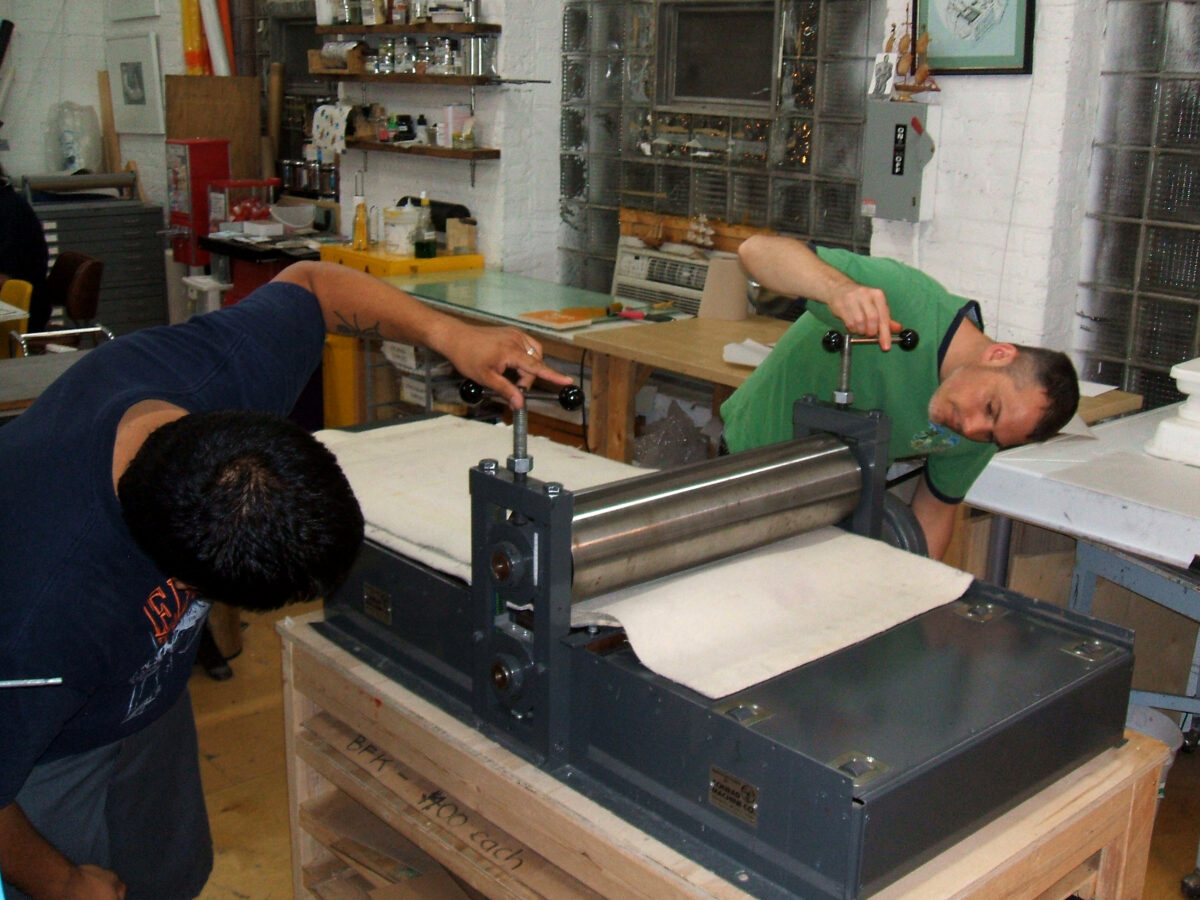
2010, Widmer in Spudnik’s relief carving class
AZ: Is it the community environment that draws you in to Spudnik or is it more about having access to a studio facility?
DW: It’s definitely both, you know, because there may be one or two other places that one could go to print. The atmosphere here is, like I said, there’s just an ease or relaxation of working here where it’s supportive. I don’t know how else to explain it, but it’s a nice, open, light, place to work.
AZ: Since paper making in general is a very niche community, how do you feel about having a tight knit community? Would you want more people to be involved?
DW: I think it will always be a sort of niche community because of the amount of labor and effort that goes into paper making. It’s not for everybody, for sure. You need a space where it’s going to be completely wet. It’s worked out really well for me because at the art fairs, most people have not seen or heard of the medium before, so you have an immediate audience when you’re talking to people and an immediate interest because they’re learning something new for the first time, something they haven’t seen before. That’s where it worked really well in my favor. I love that it’s a small community and everybody knows of everybody else for the most part. I go to the Morgan Conservatory in Cleveland and I can talk about people I know in Chicago or Wisconsin and they all know each other. It’s really nice. I would love for more people to be introduced to paper and include it in at least part of their practice, or to collaborate with someone that makes paper. I would love for that to happen, but I don’t think that it will ever be as popular as other types of art forms because it’s just not as accessible.
AZ: Do you collaborate with other papermakers often or is this just more of a solitary experience?
DW: It’s mostly solitary. Although I’ve had papermakers come over to my studio to use the beater if they don’t have their own beater or they’re working on a specific project where they need a particular type of pulp. I’m always open to helping out someone that needs access to materials or equipment that I might have. Yeah, there’s that little bit of collaboration. It’s not often but I have worked with other papermakers on projects.
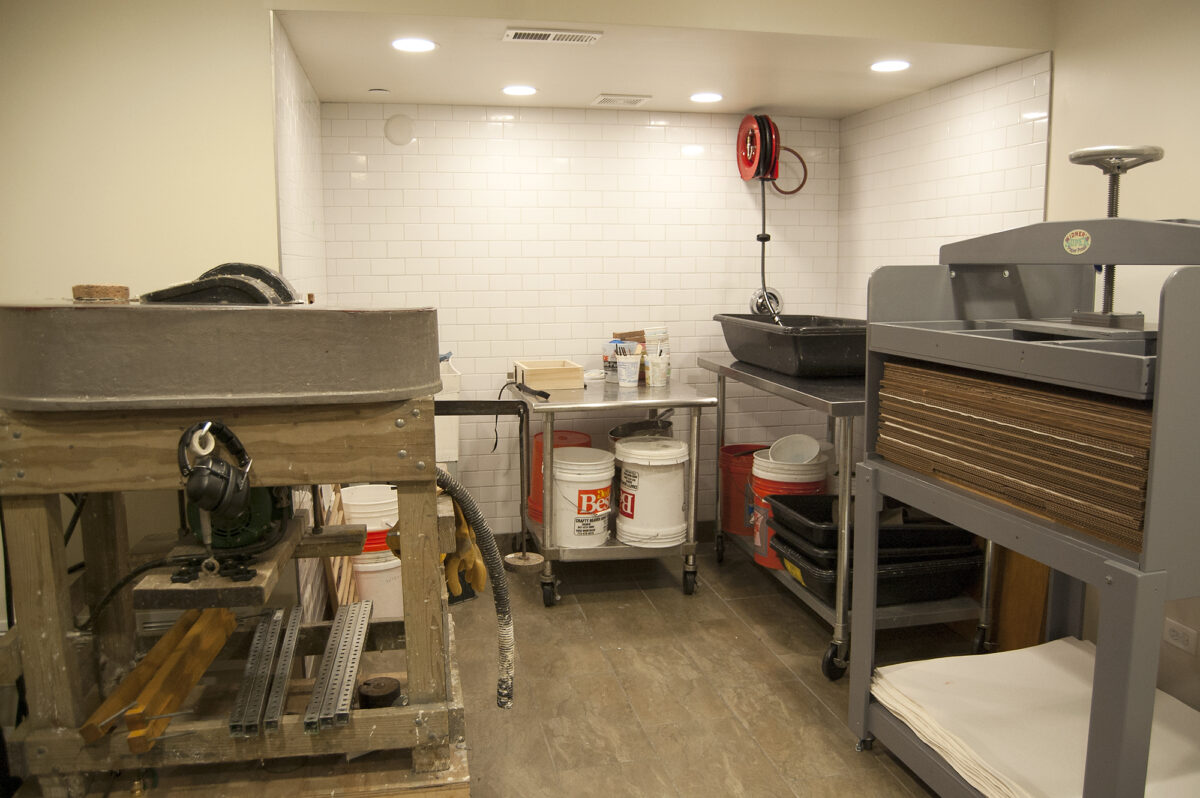
Widmer’s papermaking studio
AZ: What do the collaborations entail?
DW: One time, somebody who had little experience with papermaking was interested in a conceptual project where she was making paper from materials gathered from pieces of land that used to be gas stations. They couldn’t be used for a while because they had pollutants in the ground. She was gathering weeds or plant material from that space. We worked to create a pulp from these plant materials and made the sheets of paper. Then, she created art on those sheets of paper.
AZ: Was that one of your favorite collaborations?
DW: It was fun! It was like a new territory for both of us.
AZ: Have you been inspired by artists’ stories to create your work?
DW: Oh, I definitely am inspired by speaking with other artists. If it’s not in a place, like an art making place like Spudnik, it’s at the fairs themselves. I was just speaking to a photographer who prints on Japanese papers. She’s interested in a collaboration where I would make the paper. I’m going to experiment with making bamboo paper for the first time from cooking down the bamboo and see if I could form a paper that she can print on. This would never happen if I’m not talking to and sharing ideas and stories with other artists.
AZ: I understand that you also use native plant fibers, is there a reason why you do?
DW: It’s just experimenting. I always like to do something new. People started giving me plants from their gardens and then I would experiment. Andrea Peterson, a paper maker in Indiana, suggested it would be interesting to use Midwest plants like corn for my steel yard pulp paintings. It’s conceptual because the steel yards are no longer in existence but used to be a huge industry in the Midwest. People are really fascinated when they look at it. They’re not quite sure what the images are or what the medium is at first when they’re looking at it at an art fair. When you start talking to them and you say, “This is made from corn,” people become totally enamored by it.
AZ: Is there a show coming up that you want to share with the community?
DW: My biggest show of the year is coming up in December, which is the One of a Kind Show at the Merchandise Mart. That’s always the first Thursday through Sunday of December. […] It’s such a fun show and there’s so many different types of art to see. I always really have a good time there.
AZ: Are there any other places online that you want people to know about besides dwidmer.com?
DW: Yeah, on Instagram I’m @donwidmerpaperarts. That’s probably the main thing besides Facebook.